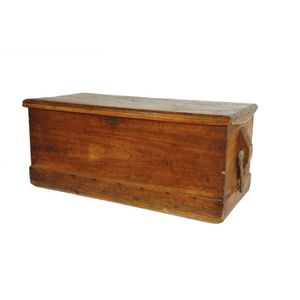Qing Dynasty Huanghuali Document Box with Bronze Mounts
You must be a subscriber, and be logged in to view price and dealer details.
Subscribe Now to view actual auction price for this item
When you subscribe, you have the option of setting the currency in which to display prices to $Au, $US, $NZ or Stg.
- Ming Dynasty - The Ming Dynasty was a ruling dynasty of China from 1368 to 1644. It succeeded the Yuan Dynasty and preceded the Qing Dynasty. The Ming Dynasty was established by Zhu Yuanzhang, a former Buddhist monk who became a rebel leader and eventually overthrew the Mongol Yuan Dynasty. During the Ming Dynasty, China experienced a period of relative stability and prosperity. The government was centralized and bureaucratic, with the emperor at the top of the hierarchy. The Ming Dynasty is known for its cultural achievements, including the development of porcelain, the invention of movable type printing, and the construction of the Great Wall of China.
- Qing Dynasty - The Qing Dynasty was the last imperial dynasty of China, ruling from 1644 to 1912. It was established by the Manchu people, who originated from the northeastern region of China. The Qing Dynasty was preceded by the Ming Dynasty and followed by the Republic of China.
- Huanghuali Wood - Huanghuali is the most sought-after timber used in the construction of Chinese furniture because of its fine colour and grain.
During Ming and early Qing dynasties, most of the best furniture was made from huanghuali wood.
It is a member of the rosewood family and over time the surface mellows to a yellowish brown tone with the exposure to light.
In recent years, furniture made from huanghuali wood has increased exponentially in value. - Bronze - An alloy of copper and tin, traditionally in the proportions of about 9 parts of copper to 1 part of tin.
The discovery of bronze in Western Asia in the 4th century enabled people to create metal objects which were superior to those previoulsy possible because of its strength and hardness, and it has been used throughout the world for weapons, coins, tools, statuary and other decorative items.
It is very fluid in a molten state, and its hardness, strength when set, and non-corrosive properties makes it most suitable for casting sculpture.
This item has been included into following indexes:
- Chinese furniture, chairs - chairs, Qing dynasty 337
- Chinese furniture, timbers
Visually similar items

Chinese yellow burl hardwood box. Metal fastener. Weight 18 cm diameter 13 cm height 11 cm

A maritime cabin trunk with domed top, pine and iron, 18th century A maritime cabin trunk with domed top, pine and iron, late 18th century top with illegible inscription 35 cm high, 72 cm wide, 35 cm deep

A good 19th century camphorwood travel trunk, the one piece top with rounded edge, hinged opening to reveal a plain sectional interior, dove-tailed construction, plinth base, the rope handles supported by angular form blocks, good old character. 107 cm x 4

A carpenters tool trunk, Australian red cedar, 19th century, fitted with compartment and drawers, 51 cm high, 103 cm wide, 50 cm deep
